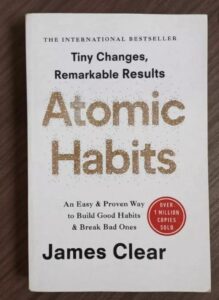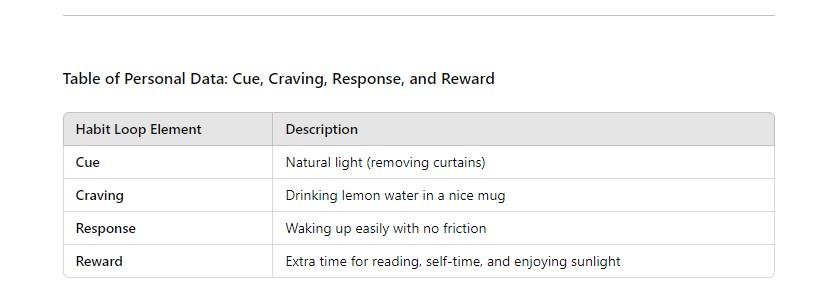The Day You Transform Your Life with Habits……
Alright, let’s talk habits. Inspired by James Clear’s “Atomic Habits,” we’re diving into how small, consistent actions can make a huge difference in your life. Just like that moment you realize you’ve been scrolling Instagram for an hour—except this time, we’re focusing on building something positive.

Atomic Habits by James Clear is a highly practical book on habits. It is filled with numerous examples that clearly explain how habit formation works. This isn’t just based on hearsay; the book provides detailed explanations and evidence to back up its claims.
Let’s start
The Power of Tiny Changes
At the heart of “Atomic Habits” is the idea that small, incremental changes—atomic habits—can compound over time to produce significant improvements. Clear argues that if we get just 1% better each day, those tiny gains add up.
Four Simple Rules for Build Good Habit
Cue:- Make It Obvious.
Craving:- Make It Attractive.
Response:- Make It Easy.
Reward:- Make It Satisfying
Four Simple Rules for Break Bad Habit
Cue:- Make it Invisible.
Craving:- Make it Unattractive.
Response:- Make It Difficult.
Reward:- Make It Unsatisfying.
Let me quickly explain these four rules and provide many examples so you can easily understand them. Don’t worry, I won’t use any extra words that make this long and difficult to read. I will keep it simple and straightforward.
Cue:- Make It Obvious / Invisible.
A cue is a trigger point; the more obvious you make it, the easier it will be to build the habit because it’s the starting point.
For example,
Placing your running shoes next to your bed can be a good cue to start your morning jog.
Setting a book on your pillow can remind you to read before bed.
Keeping a bowl of fruit on the kitchen counter encourages healthy snacking.
Conversely,
leaving a pack of cigarettes on your desk can be a bad cue, making it harder to quit smoking.
Having junk food visible on the counter can lead to unhealthy eating habits.
Craving:- Make It Attractive / Unattractive.
Craving is what makes you feel motivated to do something. You can link it to your social image to turn it into a good habit. For example, you might think, ‘If I stay fit, people will like me,’ and you can achieve fitness through exercise. This creates a craving to be fit, which motivates you to exercise.
So basically, Craving is the motivational force behind every habit. To make a habit attractive, pair it with something you enjoy.
For example,
If you love listening to music, only allow yourself to listen to your favorite playlist while jogging.
If you enjoy a specific type of tea, have a cup while reading your book before bed.
To make eating healthy more appealing, try incorporating your favorite flavors into healthy recipes.
On the flip side, make bad habits unattractive by associating them with negative consequences.
For instance, if you’re trying to quit smoking, think about the health issues it can cause.
If you’re avoiding junk food, remind yourself how sluggish it makes you feel afterward.
Response:- Make It Easy / Difficult.
The response is the actual behavior you perform. To make a habit easy, reduce the friction required to perform it.
For example,
If you want to start jogging, lay out your running clothes and shoes the night before.
To encourage reading, keep your book within easy reach on your bedside table.
For healthy eating, prep your meals in advance and keep healthy snacks ready to grab.
Conversely, make bad habits difficult to do.
For instance,
Store cigarettes in a hard-to-reach place
or
Don’t keep junk food at home.
The harder it is to access these items, the less likely you are to use them.
Reward:- Make It Satisfying / Unsatisfying.
The reward is the benefit you gain from performing the habit. To make a habit satisfying, reward yourself immediately after completing it.
For example,
After a jog, enjoy a relaxing shower or treat yourself with a smoothie.
After reading a chapter, allow yourself to watch an episode of your favorite show.
After eating a healthy meal, savor a small piece of dark chocolate.
On the other hand, to break a bad habit, make it unsatisfying.
For instance,
Keep a journal of how much you spend on cigarettes and how it affects your budget.
Similarly, track your energy levels after eating junk food and note the negative impact on your day.
You can also make your long-term goal a rewarding point, which you directly receive,
Like reading books to increase your knowledge, something you can feel yourself and which serves as a significant reward directly linked.
Similarly, jogging and exercising can make you feel stronger in your body.
Eating healthy foods can make you feel more flexible.
Likewise, if you quit smoking and start seeing yourself as a non-smoker, you can take pride in yourself.
Avoiding junk food can make you feel healthy, strong, and active again.
Yes, this direct reward may take time, perhaps 6 months to a year or even longer, but once you feel this reward, you’ll embrace the habit in a much better way.
Personal Example of Applying Atomic Habits
A few years ago, I used to wake up quite late. After reading the book “Atomic Habits,” I decided to start applying its principles. First, I needed to identify a cue. I chose an alarm as my trigger point and set it for a specific time before going to bed. The craving that developed was the desire to have extra time before going to the office, which I could use for reading, exercising, etc. However, the problem lay in the response because it was easy for me to turn off the alarm and go back to sleep. This loop did not work for me.
Then, I thought more about it and heard in a podcast by Naval Ravikant that he keeps the curtains open so he can wake up naturally with sunlight. I decided to do the same and removed the curtains. Now, my cue or trigger point was natural light. I also changed my craving: after waking up, I started drinking lemon water with warm or sometimes normal water in a nice mug. The response became quite easy because there was no friction. The reward was that I got extra time, which I could feel myself. Reading books, spending time with myself, and sitting in sunlight were all rewards.

This real-life example should make it easier for you to understand.
In wrapping up, remember, the journey to building better habits is a marathon, not a sprint. If you’re hungry for more insights and actionable tips, check out Atomic Habits by James Clear. Here’s to embracing the power of small changes for big results!.
Thank you _